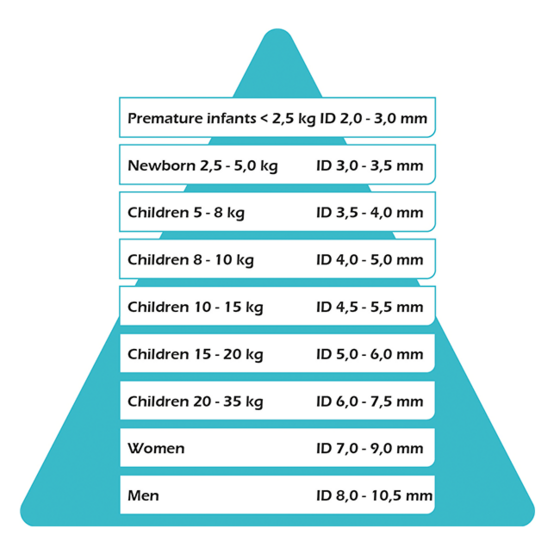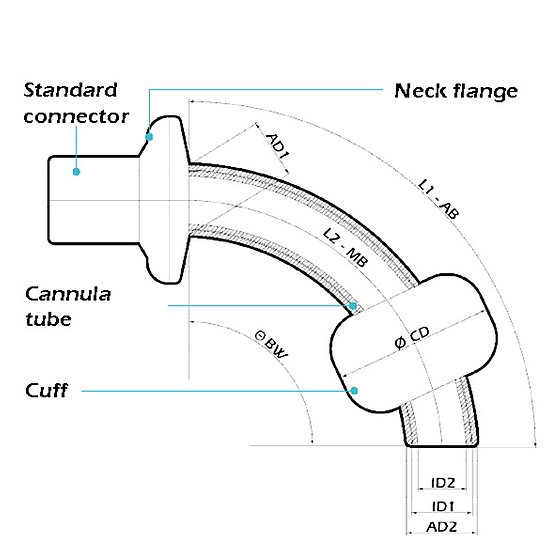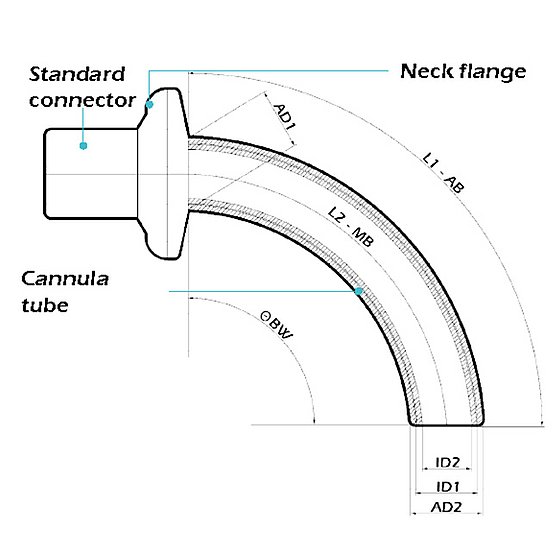Choosing the right tracheostomy tube
Various factors play a role in the decision to use a tracheostomy tube, whereby the focus should always be on a suitable fitting for the individual. The diagnosis is crucial here (laryngectomy, laryngectomy with tracheoesophageal shunt, tracheotomy, ventilation). When searching for the right tracheostomy tube, it is necessary to ask in detail about factors that are decisive for finding right the product.
Choosing the cannula size
When selecting a tracheostomy tube, one should ensure that a tracheostomy tube with the largest possible internal diameter is used. This both allows the cannula wearer to breathe safely with little resistance and reduces the risk of obstruction of the lumen due to accumulation of secretions.
To avoid the accumulation of secretions in the tracheostomy tube, it is possible to use tubes with an inner cannula. The inner cannula can be removed quickly and cleaned if necessary. This avoids having to change the entire outer cannula. In the selection of tracheostomy tubes of different materials, it should be noted that the material strength could also influence the inner volume of the cannula. For example, because of the relatively thick-walled material, a plastic cannula has a smaller inner lumen than the thin-walled silver cannula. When making a comparison, therefore, both the inner diameter (I. D.) and the outer diameter (O. D.) need to be taken into account. In practice, this has an impact especially when a cannula type is being changed (e.g. from a silver cannula to a plastic spiral cannula).
Of course, the first thing to pay attention to is the outer diameter, which is relevant for the exact adaptation of the tracheostomy tube to the individual anatomy of the tracheostoma and the trachea. When selecting the size, it should be noted that the different materials and their respective wall thicknesses have different effects on the outer diameter. For example, a tracheostomy tube in size 9 results in a 2 - 5 mm larger outer diameter, depending on the preferred material.
In addition, the tracheostomy tube needs to be checked to see whether it is a tapered tracheostomy tube or a cylindrical tube, whereby tapered tracheostomy tubes are more comfortable to insert when changing the tube. As tapered tracheostomy tubes have a smaller diameter at their tip than immediately behind the neck flange, the standard defines that the size designation of the tube refers to the inner diameter at the tip of the tube.
When changing to a different type of cannula while taking the outer diameter into account, it must also be taken into consideration that the inner diameter may be reduced due to the material used. The subjective breathing sensation of the cannula wearer may be impaired here (shortness of breath/performance restrictions). In terms of phonation, a larger inner diameter can sometimes be problematic for the patient, as the pressure of the airflow decreases, making it more difficult to speak.

The following information is based on experience and can be used as a guide for the use and sizing of tracheostomy tubes:

Care should be taken to ensure that in children the cannula needs to be continuously adjusted according to the stages of growth/development.
Material properties of the cannulas
| Advantages | Disadvantages |
|---|---|
|
|
|
|
|
|
|
|
| |
|
| Advantages | Disadvantages |
|---|---|
|
|
|
|
| |
| |
| |
| |
|
| Advantages | Disadvantages |
|---|---|
|
|
|
|
| |
| |
| |
|
| Advantages | Disadvantages |
|---|---|
|
|
|
|
| |
| |
|
| Advantages | Disadvantages |
|---|---|
|
|
|
|
|
|
|
|
|
| Advantages | Disadvantages |
|---|---|
|
|
|
|
| |
|
Choosing the cannula length
When selecting the length of the tracheostomy tube, the special conditions of the tracheostoma and trachea play a decisive role. To provide effective prophylaxis against tracheomalacia or tracheal stenosis, care should be taken to alternate tracheostomy tubes of different lengths. In general, extra-long tracheostomy tubes are ideal for bridging stenoses, whereas short tubes are well suited for the exclusive stabilisation of the tracheostoma, e.g. after a laryngectomy. They largely avoid irritations such as foreign body sensation, increased secretion, etc.
Today, there is a wide range of materials that are used to manufacture tracheostomy tubes. Incompatibilities with materials should be avoided here (e.g. allergies to silver or latex).


AD1 = Outer diameter at the neck flange
AD2 = Outer diameter of the tip of the cannula
ID1 = Inner diameter at the cannula tip of the outer cannula
ID2 = Inner diameter at the cannula tip of the inner cannula
L1-AB = Length over the outer curve
L2-MB = Length over the central arch
θ - BW = Bending angle
ø - CD = CUFF diameter
IC = Inner cannula
AK = Outer cannula


